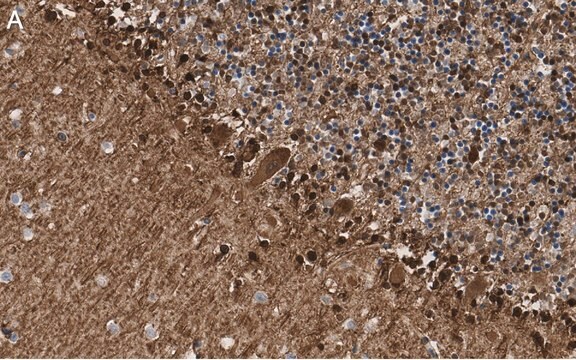Key Documents
S2657
Anti-S100B Antibody
mouse monoclonal, SH-B4
Synonim(y):
Anti-NEF, Anti-S100, Anti-S100-B, Anti-S100beta
About This Item
Polecane produkty
product name
Monoclonal Anti-S-100 (β-Subunit) antibody produced in mouse, clone SH-B4, ascites fluid
pochodzenie biologiczne
mouse
Poziom jakości
białko sprzężone
unconjugated
forma przeciwciała
ascites fluid
rodzaj przeciwciała
primary antibodies
klon
SH-B4, monoclonal
zawiera
15 mM sodium azide
reaktywność gatunkowa
sheep, bovine, goat, pig, feline, rabbit, rat, canine, human
metody
immunohistochemistry (formalin-fixed, paraffin-embedded sections): suitable (: suitable)
indirect ELISA: suitable (:suitable)
western blot: 1:100-1:200 ( (using S-100B Protein, Bovine Brain))
izotyp
IgG1
numer dostępu UniProt
Warunki transportu
dry ice
temp. przechowywania
−20°C
docelowa modyfikacja potranslacyjna
unmodified
informacje o genach
human ... S100B(6285)
rat ... S100b(25742)
Opis ogólny
Specyficzność
Immunogen
Zastosowanie
Immunocytochemistry (1 paper)
Działania biochem./fizjol.
Oświadczenie o zrzeczeniu się odpowiedzialności
Nie możesz znaleźć właściwego produktu?
Wypróbuj nasz Narzędzie selektora produktów.
polecane
Kod klasy składowania
10 - Combustible liquids
Klasa zagrożenia wodnego (WGK)
WGK 3
Temperatura zapłonu (°F)
Not applicable
Temperatura zapłonu (°C)
Not applicable
Certyfikaty analizy (CoA)
Poszukaj Certyfikaty analizy (CoA), wpisując numer partii/serii produktów. Numery serii i partii można znaleźć na etykiecie produktu po słowach „seria” lub „partia”.
Masz już ten produkt?
Dokumenty związane z niedawno zakupionymi produktami zostały zamieszczone w Bibliotece dokumentów.
Klienci oglądali również te produkty
Nasz zespół naukowców ma doświadczenie we wszystkich obszarach badań, w tym w naukach przyrodniczych, materiałoznawstwie, syntezie chemicznej, chromatografii, analityce i wielu innych dziedzinach.
Skontaktuj się z zespołem ds. pomocy technicznej









